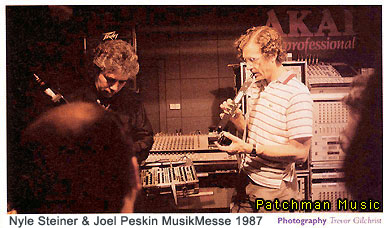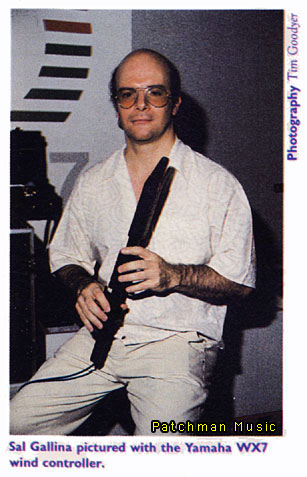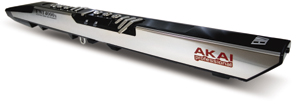


Nyle Steiner
Sal Gallina
Interview



Nyle Steiner
Sal Gallina
Interview

|
|
|
|
|
|
|
|
|
|

Buy your EWI5000, EWI USB, & EWI4000s from Patchman Music- The Wind Controller Specialists!! Click here to buy your EWI5000, EWI USB, & EWI4000s from Patchman Music We personally set up and calibrate EVERY EWI we sell. |
THE POWER OF WIND
Pioneers Nyle Steiner and Sal Gallina
By Nick Armington and Lars Lofas
From Music Technology Magazine - December 1987
The dawn of affordable wind synthesis is upon us and with it has come a new set of concerns and a new generation of instruments. We've tracked down two of the most important people involved in their creation to talk about their design considerations and the movement's implications.
THOSE OF US whose musical memories vaguely recall the original version of "La Bamba" as one of our earliest childhood memories are part of a large generation who've never known the experience of living in a pre-electric instrument world, when big bands and symphony orchestras were music, plain and simple. While no one can deny that the saxophone has its place in contemporary music, modern wind players are rarely able to stand as dominant musicians in an ensemble setting. But the times, as the man said, are a changin'.
![]() Wind Synthesis
Wind Synthesis
A MINOR REVOLUTION is brewing in the big world of music, one which affects a particular class of musicians who have until now been bypassed by electric instruments. Sax and woodwind players have always struggled for mic time on stage and in the studio, and many look at synthesizers as things to be wary of. With the advent of major new advances in wind synthesizers and controllers, though, wind synthesis might just take off as the hottest new trend of the end of this decade.
Admittedly, trends come and go - and most are better off gone - but the music industry seems to be genuinely excited about wind synthesis, and with good reason. To be sure, the subject matter isn't new. It's been around for more than a decade. But for the first time, wind controlled synthesizers are now within the grasp of the common man, at least financially.
Plus, in today's sound, wind is hot. Artists like Michael Brecker, Kenny G and David Sanborn are bringing a new romanticism to mass appeal music. More and more, wind instruments are taking center stage, and even traditional horn sections such as the Tower of Power are enjoying tremendous success after a lull in the early part of the decade.
More importantly, wind players now have the opportunity to step out for more than the occasional solo or background fill. Wind synthesis allows the instrument to reproduce a variety of sounds and timbres. In effect, wind synthesizers take traditional keyboard synthesis several magnitudes farther by adding a new style of control to the generated sound.
![]() The Instruments
The Instruments
WIND CONTROLLERS / SYNTHESIZERS have been around almost as long as their keyboard brethren. The problem has always been accuracy and control. The touch-sensitive keyboard is a relatively recent innovation, and even with the advent of MIDI, certain control elements such as polyphonic aftertouch remain elusive in most synthesizers.
Wind instruments, on the other hand, derive much of their impact through their range of control and sound. MIDI has never been well equipped to handle this facet of sound shaping, and some feel it isn't able to do so properly. Early wind controllers such as the Lyricon relied on proprietary controller methods within their instruments, which often resulted in major compatibility problems when interfacing with other instruments.
The new generation of wind synthesizers/controllers from Yamaha and Akai have been designed to address the very issue of control, which has made wind synthesis such an elusive entity. Chances are good that even if you've never seen a wind synthesizer, you've heard one many times. Up until now, they've been available only to a chosen few, although they have been used extensively in film, jingle and session work.
To get a better idea of what's going on in this field, we spoke at length with two men who have played pivotal roles in the history of wind synthesis, as well as the development of the latest electronic wind controllers: Sal Gallina, who worked with Yamaha Corporation on the design and development of the WX7 MIDI Wind Controller; and Nyle Steiner, who designed the Akai EVI1000 Electronic Valve instrument and the EWI1000 Electronic Wind Instrument.
Sal Gallina is a design consultant to Yamaha, as well as one of New York City's most requested session musicians. He describes himself as "the kid who never played baseball while growing up," instead concentrating on music study and a passion for electronic tinkering. Gallina's musical background ranges from jazz to rock to the classics, though what he seems to love best is a bit hard to describe. But the sound is big, very big. Symphonic might be the best way to describe it.
Nyle Steiner grew up in Utah, later moving to California, where he worked for years designing prototypes of electronic wind controllers for use in film scoring and studio work. He studied trumpet and music at the University Of Utah, later playing with the Utah Symphony. His influences range from Miles Davis to Itzhak Perlman, and to this day he considers himself to be in a rare category - professional musician and professional designer.
Both have a strong interest in creating sounds and textures which allow their respective instruments to be utilized to their fullest. However, the ways in which they went about creating or helping to create their respective "axes" are quite different, as are the end results. Since we believe that all things go back to their source, understanding the men who made the machines might just be the best way to understand what this brave new musical genre is all about. Hence, from here on in - with the help of two separate interviews - we'll let the musicians do the talking...
Music Technology: Both of you have approached your instruments
from a basis of personal need. In a way, you're just making public
something which has been a part of your respective lives for
years. How did you get started in wind synthesis/wind control?
Sal Gallina: "Well, I started playing when I was nine years old, on the recorder. I graduated to flute, oboe, clarinet, sax - the whole bit. I really liked playing, so I started to develop some road rash, playing out a lot by myself and with groups. I used to show up at clubs with my alto sax all wired up. I was really into the alto, and put pickups and other devices I made onto it. This was during the late '60s. I played at Max's Kansas City a lot with a band called Krom!"
Nyle Steiner: "I studied music at the University of Utah and was always a trumpet player professionally. I started to think about how to make an electric trumpet in the late '60s, at least from the design side. Things formulated from there."
MT: So there were quite a few prototypes in between?
NS: "Yes. The first EVI came out in 1979, Crumar produced the instrument, and it was quite different from the more recent ones. I guess I've done about five or six major prototypes taking advantage of new technology and in some cases even creating it when I couldn't find what I wanted. I hadn't really ever thought of modifying the trumpet to electrify it, so my designs had to be based around the concept of starting from scratch. They were always instruments unto themselves, so I was also busy studying synthesizer circuits and things like that which I built right into the instruments."
SG: "You've got to know that I'm most interested in sounds, and what electric music can do. I liked playing with these huge 15" speaker cabinets, getting a lot of different sounds from them. I made all of my own instruments - I called them 'Kromulizers.' One day I discovered that if I got close enough to the speaker, with a saxophone which was wired with octave dividers, the pressure coming from the speakers resonated the saxophone. So I started pressing the keys and playing the instrument that way, getting these incredible harmonic structures. Parts were expensive back then - you paid $15 for switches that now cost 50 cents, so it was tough. But I got into putting relays on my saxes which controlled some of the earliest synthesizers, like the ARP Odyssey. I'd just wire up relays to the keyboard busses after I took the keyboard out - so the sax keys would play the synthesizer. Later, I had this computerized saxophone with relays attached to synthesizers and controllers."
MT: So this all led up to your respective work on the EWI/EVI and the WX7?
NS: "I've actually been playing versions of the EVI professionally for years, since about 1973. Of course, the design of it has become more refined as the years have progressed, but the basic concepts are still the same. This instrument's strength and uniqueness is based on the fact that it has increased control and expressiveness. I got involved with Akai fairly recently, in the summer of 1986. They liked the prototypes I was using, and were great on improving the software in the unit. The EVI is quite software-intensive, and I've been able to get a lot more out of it with the new software."
SG: "Yamaha found me, actually, about three years ago. I had gotten pretty good at making analog sounds on synthesizers, and they were just beginning to see the success of their FM Digital Synthesis concept. At first, I wasn't quite sure what to make of it, so I kept my Oberheims and my ARPs around to be sure that I could get the sounds I wanted from digital."
"Yamaha always believed that their success would come from attracting the best engineering talent - they invest in brains and creativity, and a lot of their best and most successful ideas have come from musicians. They listen to people. So the beginning of my consulting work with Yamaha revolved around really getting into what I wanted to see from a wind controller."
"We decided early on that the design would revolve around MIDI, and would take advantage of all the parameter controllers that they were building into their synthesizers, such as breath control, which has really been under-utilized. It's an amazing feature."
 MT:
So design factors come in fairly early?
MT:
So design factors come in fairly early?
SG: "Absolutely. I've seen about five versions of the WX7 before the latest one which they're releasing now. They took many of the ideas which I had done with analog synthesizers, especially matrixing concepts, and fit them into the realm of MIDI. It's a pretty sophisticated little device for something that weighs less than a pound."
"One thing that I felt was really important was keeping the instrument user-definable in certain ways. For example, the keys on the WX7 are adjustable, which is something that sax players find essential. There's also a lot of adjustment in the mouthpiece dynamics, so that it simulates a different feel electronically to fit different playing styles."
MT: As long as we're on the subject, the designs of the mouthpieces on both instruments seem quite different. How did each of you approach this part of the instrument?"
NS: "One of the most important considerations for the EVI and the EWI was finding a good pressure transducer in the mouthpiece to take breath pressure and convert it to voltage. When I first started, there wasn't anything available, so I spent a lot of time developing my own pressure sensor. I didn't worry about simulating a reed effect, but instead worked on the aperture effect. I also worked on finding a way to make pitchbending and vibrato smooth and fluid in a way that it feels good to the performer."
"This mouthpiece is something totally new - it's not an attempt to simulate something else, but rather the ideal mouthpiece for this instrument. For example, the EWI has a natural vibrato created by biting on the mouthpiece. Of course, you can also do double tonguing on it, which you can't do on a saxophone. All of the tonguing effects and circular breath are easy, because the mouthpiece is unobtrusive."
SG: "The WX7 has a reed, but it doesn't vibrate. We did fashion the mouthpiece around the familiar clarinet/sax type of mouthpiece. In a real sax, the reed just shapes the sound wave. But the WX7's really controls the whole instrument. Just inside the mouthpiece is a pressure sensor attached to an A-to-D converter. There's also a bend lever inside there, a metal lever which is incredibly responsive, and a few other secrets."
"We adapted a lot of Yamaha's breath controller technology for the WX7. But what's more important is the fact that their synthesizers have the ability to take full advantage of breath control. You don't find that in many others. The WX7's mouthpiece is adjustable to the player, and allows the player to control aftertouch, velocity, pitchbend and of course, breath control."
"I think that this instrument overcomes a lot of the shortcomings of earlier wind controllers, and adds innovations that haven't appeared on any previous instrument of any type. Besides, I've played them all, and the overall responsiveness of this mouthpiece is just unbelievable."
MT: What about design considerations in the rest of the instrument?
SG: "I wanted the instrument to be light, adjustable to the player and simple to use the first time it's picked up. For example, the keys are arranged in the standard 14-key Boehm system which sax players are used to. Then underneath the instrument are a set of buttons for octave switching, chord holding and sustain, a MIDI pitchbend controller and a MIDI transmit key which can send program changes."
MT: Wait a sec. What's this about chord holding?
SG: "Believe it or not, the WX7 can transmit on more than one MIDI channel so you can actually build and hold these big chords just by using the chord hold feature. It makes me into an orchestra of sorts."
MT: Nyle, we could find only one moving part on the EWI, a set of smaller rollers on the underside.
NS: "That's right. Those are for octave selection. The instrument has a seven octave range, and you just roll your thumb along these to select an octave. Other than these, there aren't any other moving parts on the controller part except for the flexible mouthpiece. Every other part on the instrument is touch-sensitive, which lets you play with greater speed and accuracy. On the EVI, a lot of the functions which a trumpet player would control with the mouth are controlled with the left hand instead. There are special trill keys right next to the main valve keys."
MT: And then either the EVI or the EWI connect to the some control unit...
NS: "...which is called the EWV2000 MIDI Sound Module. It's a combination of instrument controls and analog synthesizer modules, with outputs to other MIDI devices. You need to have both, because the EWV2000 contains a lot of the controls for the EVI and the EWI, which allows the performer to modify many of the parameters while playing, such as breath sensitivity, modulation depth and similar functions."
MT: So in effect any MIDI device can be hooked up to either instrument?
SG: "Yes. The WX7 is connected to a small battery pack which hooks to your belt, and you just plug a MIDI cable into that. There's no separate control unit, which makes the WX7 totally portable on stage. When wireless MIDI transmitters come out, I'll be able to cut the cord altogether. I plug my WX7 into a rack with two signal processors and one tone generator. That's all I really need to make the big noise."
NS: "The EWV2000 has a complete MIDI patching system onboard, and you can adjust a number of the unit's parameters while you play. By turning the breath sensitivity control all the way up, you don't even have to blow into the instrument - ordinary room pressure triggers the electronics, so you can play the keys while fiddling with the control knobs on the Sound Module."
MT: OK. You say that everybody's heard these instruments. But what kind of sounds are built into them?
NS: "I've done a lot of the sounds myself for the EWV2000. Of course, you can bypass the sound generators and go directly to samplers or other MIDI devices, or you can route the output of external sound sources through the EWV2000, utilizing its breath-controlled VCF and VCA capabilities."
"For one thing, on a traditional keyboard synthesizer, the EG is usually preset in some combination of attack, decay, sustain and release. But the EVI and EWI control these parameters, so you can get a wide range of envelopes from the controller itself. In fact, you could say that one patch on the EVI/EWI is like 10 on a normal keyboard, due to the range of expressiveness. The sounds in the module tend to be more on the sustained side. We left the rhythmic things for the keyboards. But of course breath can be used to open up either the filters, the VCA, or both. So there's an infinite number of combinations, and we made it easy to add to the 64 presets."
MT: Sal, you're probably best known for your sounds, even long before you played the WX7.
SG: "That's nice to know. I do care a great deal about sound. I've spent many, many years studying how sounds work, not in school, but by locking myself into a room and trying different things. What ticks me off is that all too often these companies spend millions of R&D dollars developing an LSI chip and then don't spend a dime analyzing and reproducing sounds."
MT: A lot of people who heard your performances at lost summer's NAMM show in Chicago were really blown away by your Hendrix impression...
SG: "Jimi Hendrix and Jimmy Page are great. I created this sound called 'Power 1' just to pay homage to them. And it's the same way with all my other sounds. I don't care if it takes me until 4am to get the sound I want. Once I get that sound, I can close my eyes and feel that I am playing that instrument. It's a real rush to have all that work pay off."
(Editor's note: Those interested in learning more about Gallina's approach to programming FM synths can read his new book, "Expressive FM Applications," which also includes a cassette containing some of his best patches for the TX81Z DX7, SPX90 and REV7. The package was included with the WX7.)
MT: Although both instruments are quite new, how have other professionals reacted to the concepts in them?
NS: "Real well, I think. What a lot of people don't know is how much the EVI has been heard on different projects. I've used it on the scores to Witness, Star Trek III, No Way Out, Fatal Attraction, and a lot of TV shows like St. Elsewhere and Knot's Landing. Michael Brecker has been using the EWI and loves it."
"I think that, like anything new, there are always people who need convincing but once they hear the instrument they'll be pleased. A lot of people who've used wind controllers in the past know about their earlier limitations, especially pitch-to-voltage problems. I never liked pitch followers - the concept was complicated and even though I was able to make some working prototypes which used pitch followers, I never got the right 'feel' from them. To a professional, 'feel' is critical. So while trumpet players will have to learn some new things about the EVI, I think they'll really enjoy it. Sax players will probably pick up on the EWI right away. It's real comfortable for them."
SG: "I've been using the prototypes of the WX7 from its developmental stage until now, on albums for RCA, CBS, Polygram, Arista and Capitol Records as well as on countless jingle and scoring sessions. Actually, what keeps changing is the contents of my effects rack. Right now, to get all the sounds I do, I use a $500 synthesizer module made by Yamaha called the TX81Z. It's one of their basic four operator FM synthesizer modules."
MT: So you've both seen positive reactions to what comes out of the machines?
SG: "Most definitely. People, hip people, know that this is just another evolution in music, and they've been great in going along with it."
NS: "I believe that wind players think a lot differently than keyboard players. Keyboard players tend to play rhythmically, while wind players are more fluid. Wind instruments are just naturally more expressive, so each note stands out as unique. Many of the sounds I programmed into the EWV are designed with this thought in mind."
MT: Do you think that we might see some negative reaction to these new instruments from more traditional players?
NS: "It's hard to say. Certainly the professional community here in Los Angeles is picking up on this thing (the EVI/EWI) quickly. It's real easy to use, and a lot of people have told me that they feel good about playing it. But opinions are so hard to judge."
SG: "The thing is, there are always people who resent change or progress. They're the ones who say, 'Why use a light bulb when we have perfectly good candles?' But seriously, musicians will come to see the value in wind controllers pretty quickly once they give them a try. There will always be purists who hate anything that's electrified, and we might see some backlash as we did when the electric guitar came out, then the electric piano and later electronic drums. But look how those things have flourished. Change is change, and I'm all for it."
MT: Speaking of change, can we get some final thoughts on where you see wind synthesis and music in general going?
SG: "I really hope that we'll see a MIDI-2 standard appear before too long. When they first dreamed up MIDI, it was a simple control system. Nobody thought much about timecode, song pointer, or the need to ever use more than 16 channels. MIDI is kind of like the Brooklyn Bridge... too crowded and not enough lanes. So now that 32-bit technology is popping up everywhere, we really can't expect that MIDI can stay in the 8-bit, 31 kilobaud realm forever."
NS: "I think that wind synthesis will go about as far as people let it go. It's so hard to judge. Where I see continuing improvements is in the area of software development and how software relates to sound. This is an area where the Japanese are doing some great work, and it will be interesting to watch and see how systems progress as they rely less and less on hardware, and more and more on software."
----
Nick Armington and Lars Lofas are producers, musicians and studio contractors who really do live in New York City and like it.
The Wind Controller FAQ | Wind Controller Soundbanks
| Be sure to check out the amazing Aerophone Academy Podcast co-hosted by Patchman Music's own Matt Traum and Alistair Parnell (iSax Academy) for in depth discussions and interviews on everything related to wind controllers! |


Check out the INCREDIBLE PATCHMAN TURBO VL Upgrade Chip for the Yamaha VL70-m |

This page was last updated Wednesday, August 6, 2025
Copyright ©1996-2025 PATCHMAN MUSIC, LLC, All Rights Reserved
Purchase Terms and Conditions
All trademarks are property of their respective holders


